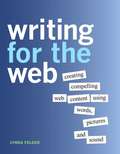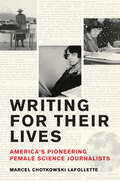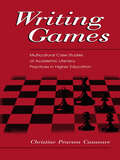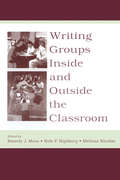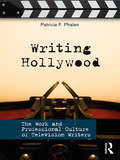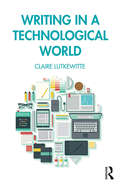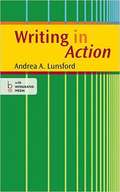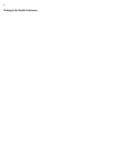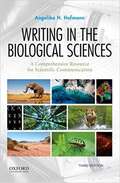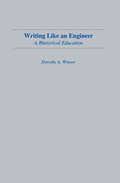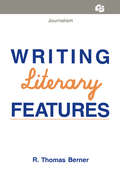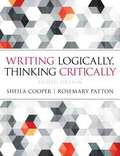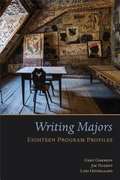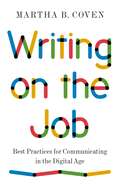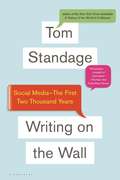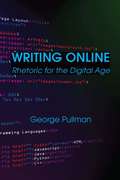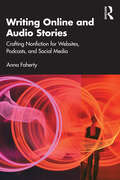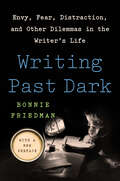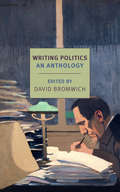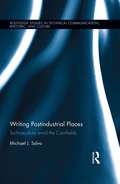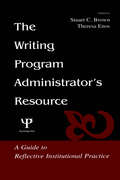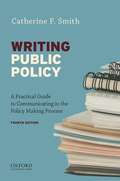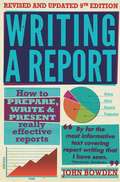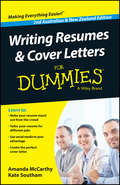- Table View
- List View
Writing for the Web: Creating Compelling Web Content Using Words, Pictures and Sound
by Lynda FelderWith Writing for the Web, you'll learn everything you need to know to create effective Web content using words, pictures, and sound. Follow along as instructor and writer Lynda Felder combines easy-to-follow guidelines with photographs, lists, and tables to illustrate the key concepts behind writing nonlinear, interactive stories; creating succinct and clear copy; and working compelling images, motion graphics, and sound into your content.
Writing for Their Lives: America’s Pioneering Female Science Journalists
by Marcel Chotkowski LaFolletteA breathtaking history of America&’s trail-blazing female science journalists—and the timely lessons they can teach us about equity, access, collaboration, and persistence.Writing for Their Lives tells the stories of women who pioneered the nascent profession of science journalism from the 1920s through the 1950s. Like the &“hidden figures&” of science, such as Dorothy Vaughan and Katherine Johnson, these women journalists, Marcel Chotkowski LaFollette writes, were also overlooked in traditional histories of science and journalism. But, at a time when science, medicine, and the mass media were expanding dramatically, Emma Reh, Jane Stafford, Marjorie Van de Water, and many others were explaining theories, discoveries, and medical advances to millions of readers via syndicated news stories, weekly columns, weekend features, and books—and they deserve the recognition they have long been denied.Grounded in extensive archival research and enlivened by passages of original correspondence, Writing for Their Lives addresses topics such as censorship, peer review, and news embargoes, while also providing intimate glimpses into the personal lives and adventures of mid-twentieth-century career women. They were single, married, or divorced; mothers with child-care responsibilities; daughters supporting widowed mothers; urban dwellers who lived through, and wrote about, the Great Depression, World War II, and the dawn of the Atomic Age—all the while, daring to challenge the arrogance and misogyny of the male scientific community in pursuit of information that could serve the public.Written at a time when trust in science is at a premium, Writing for Their Lives is an inspiring untold history that underscores just how crucial dedicated, conscientious journalists are to the public understanding and acceptance of scientific guidance and expertise.
Writing Games: Multicultural Case Studies of Academic Literacy Practices in Higher Education
by Christine Pears CasanaveThis book explores how writers from several different cultures learn to write in their academic settings, and how their writing practices interact with and contribute to their evolving identities as students and professionals in academic environments in higher education. Embedded in a theoretical framework of situated practice, the naturalistic case studies and literacy autobiographies include portrayals of undergraduate students and teachers, master's level students, doctoral students, young bilingual faculty, and established scholars, all of whom are struggling to understand their roles in ambiguously defined communities of academic writers. In addition to the notion of situated practice, the other powerful concept used as an interpretive framework is captured by the metaphor of "games"--a metaphor designed to emphasize that the practice of academic writing is shaped but not dictated by rules and conventions; that writing games consist of the practice of playing, not the rules themselves; and that writers have choices about whether and how to play. Focusing on people rather than experiments, numbers, and abstractions, this interdisciplinary work draws on concepts and methods from narrative inquiry, qualitative anthropology and sociology, and case studies of academic literacy in the field of composition and rhetoric. The style of the book is accessible and reader friendly, eschewing highly technical insider language without dismissing complex issues. It has a multicultural focus in the sense that the people portrayed are from a number of different cultures within and outside North America. It is also a multivocal work: the author positions herself as both an insider and outsider and takes on the different voices of each; other voices that appear are those of her case study participants, and published authors and their case study participants. It is the author's hope that readers will find multiple ways to connect their own experiences with those of the writers the book portrays.
Writing Groups Inside and Outside the Classroom (International Writing Centers Association (IWCA) Press Series)
by Beverly J. Moss Nels P. Highberg Melissa NicolasThis unique collection considers the nature of writing groups inside and outside the academic environment. Exploring writing groups as contextual literacy events, editors Beverly J. Moss, Nels P. Highberg, and Melissa Nicolas bring together contributors to document and reflect on the various types of collaborations that occur in writing groups in a wide range of settings, both within and outside the academy. The chapters in this volume respond to a variety of questions about writing groups, including: *What is the impact of gender, race, and socioeconomic class on power dynamics in writing groups? *When is a writing group a community and are all writing groups communities? *How does the local community of a writing group impact the participation of group members in other local or global communities? *How does the local community of a writing group impact the participation of group members in other local or global communities? *What actions contribute to a strong community of writers and what actions contribute to the breakdown of community? *When and for whom are writing groups ineffective? *What is it about belonging to a community of writers that makes writing groups appealing to so many within and beyond the academy?Each chapter highlights how writing groups, whether or not they are labeled as such, function in various spaces and locations, and how collaboration works when writers from a variety of backgrounds with diverse interests come together. Writing Groups Inside and Outside the Classroom illustrates that writing groups outside of the academy are worthy of study and serve as important sites of writing and literacy instruction. Offering significant insights into the roles of writing groups in literacy and writing practice, this volume is appropriate for scholars and teachers of writing, rhetoric, composition, and literacy; for writing center administrators and staff; and for writing group participants.
Writing Hollywood: The Work and Professional Culture of Television Writers
by Patricia F. PhalenWriting Hollywood highlights the writing process in the production of television drama and comedy series in the U.S. The way writers do their jobs is heavily dependent not only on the demands of commercial business, but also on the uncertainties inherent in a writing career in Hollywood. Drawing on literature in the fields of Media Industry Studies and Occupational Culture, Writing Hollywood explains writers’ efforts to control risk and survive in a constantly changing environment. Using data from personal interviews and a six-week participant observation at a prime time drama, Dr. Phalen analyzes the relationships among writers in series television, describes the interactions between writers and studio/network executives, and explains how endogenous and exogenous pressures affect the occupational culture of the television writing profession.
Writing in a Technological World
by Claire LutkewitteWriting in a Technological World explores how to think rhetorically, act multimodally, and be sensitive to diverse audiences while writing in technological contexts such as social media, websites, podcasts, and mobile technologies. Claire Lutkewitte includes a wealth of assignments, activities, and discussion questions to apply theory to practice in the development of writing skills. Featuring real-world examples from professionals who write using a wide range of technologies, each chapter provides practical suggestions for writing for a variety of purposes and a variety of audiences. By looking at technologies of the past to discover how meanings have evolved over time and applying the present technology to current working contexts, readers will be prepared to meet the writing and technological challenges of the future. This is the ideal text for undergraduate and graduate courses in composition, writing with technologies, and professional/business writing. A supplementary guide for instructors is available at www.routledge.com/9781138580985
Writing In Action
by Andrea A. LunsfordAndrea Lunsford’s research treats student writers as writers first—not only in the classroom, but in every aspect of their lives. Her newest handbook features a simple and inviting design that helps students find solutions for every situation as they translate their skills as writers in their day-to-day lives to the conventions of solid academic writing. Featuring the writing process coverage of larger handbooks at a value price, Writing in Action is a supportive reference that emphasizes rhetorical strategies that help students put their ideas into action.
Writing In The Health Professions
by Barbara Heifferon Stuart BrownPractical, applied, and up-to-the-minute, Writing for the Health Professions teaches students, healthcare professionals, and professional writers the essential skills in medical and health communications. Drawing on her extensive experience as a nurse, cardio-pulmonary technician, medical writer, and writing teacher, Barbara Heifferon addresses the communications requirements of the healthcare professions and those who write in these high-tech fields. This comprehensive text covers writing situations and documents common in hospitals, clinics, HMOs, health insurance companies, public health campaigns, and other healthcare environments. Special attention is given to visual and electronic forms of communication, including web sites and multimedia productions.
Writing in the Biological Sciences: A Comprehensive Resource for Scientific Communication
by Angelika HofmannPractical and easy to use, Writing in the Biological Sciences: A Comprehensive Resource for Scientific Communication, Third Edition, presents students with all of the techniques and information they need to communicate their scientific ideas, insights, and discoveries. <p><p>Angelika H. Hofmann introduces students to the underlying principles and guidelines of professional scientific writing and then teaches them how to apply these methods when composing essential forms of scientific writing and communication. Ideal as a free-standing textbook for courses on writing in the biological sciences or as reference guide in laboratories, this indispensable handbook gives students the tools they need to succeed in their undergraduate science careers and beyond.
Writing Like An Engineer: A Rhetorical Education (Rhetoric, Knowledge, and Society Series)
by Dorothy A. WinsorComprised of a study spanning over five years, this text looks at four engineering co-op students as they write at work. Since the contributors have a foot in both worlds -- work and school -- the book should appeal to people who are interested in how students learn to write as well as people who are interested in what writing at work is like. Primarily concerned with whether engineers see their writing as rhetorical or persuasive, the study attempts to describe the students' changing understanding of what it is they do when they write. Two features of engineering practice that have particular impact on the extent to which engineers recognize persuasion are identified: * a reverence for data, and * the hierarchical structure of the organizations in which engineering is most commonly done. Both of these features discourage an open recognition of persuasion. Finally, the study shows that the four co-op students learned most of what they knew about writing at work by engaging in situated practice in the workplace, rather than by attending formal classes.
Writing Literary Features (Routledge Communication Series)
by R. Thomas BernerFirst Published in 1988. Routledge is an imprint of Taylor & Francis, an informa company.
Writing Logically, Thinking Critically
by Sheila Cooper Rosemary PattonThis concise, accessible text teaches students how to write logical, cohesive arguments and how to evaluate the arguments of others. Integrating writing skills with critical thinking skills, this practical book teaches students to draw logical inferences, identify premises and conclusions and use language precisely. Students also learn how to identify fallacies and to distinguish between inductive and deductive reasoning. Ideal for any composition class that emphasizes argument, this text includes coverage of writing style and rhetoric, logic, literature, research and documentation.
Writing Majors
by Lori Ostergaard Greg Giberson Jim NugentThe writing major is among the most exciting scenes in the evolving American university. Writing Majors is a collection of firsthand descriptions of the origins, growth, and transformations of eighteen different programs. The chapters provide useful administrative insight, benchmark information, and even inspiration for new curricular configurations from a range of institutions.A practical sourcebook for those who are building, revising, or administering their own writing majors, this volume also serves as a historical archive of a particular instance of growth and transformation in American higher education. Revealing bureaucratic, practical, and institutional matters as well as academic ideals and ideologies, each profile includes sections providing a detailed program review and rationale, an implementation narrative, and reflection and prospection about the program.Documenting eighteen stories of writing major programs in various stages of formation, preservation, and reform and exposing the contingencies of their local and material constitution, Writing Majors speaks as much to the "how to" of building writing major programs as to the larger "what," "why," and "how" of institutional growth and change.
Writing on the Job: Best Practices for Communicating in the Digital Age
by Martha B. CovenA practical and compact guide to writing for professionalsWriting is an essential skill in today’s workplace. From messaging platforms and social media to traditional forms of communication like memos and reports, we rely on words more than ever. Given how much reading we do on mobile devices, being able to write succinctly is critical to success. Writing on the Job is an incisive guide to clear and effective writing for professionals.Martha Coven begins with the basics, explaining how to develop a professional style, get started on a piece of writing, create a first draft, and edit it into a strong final product. She then offers practical advice on more than a dozen forms of writing, from emails and slide decks to proposals and cover letters. Along the way, Coven provides a wealth of concrete examples and simple templates that make the concepts easy to understand and apply.Based on Coven’s popular writing classes and workshops at Princeton University as well as her decades of experience in the public and private sectors, Writing on the Job addresses the real challenges professionals face in today’s digital age, and shares essential practices that can improve the performance of any organization.
Writing on the Wall: Social Media--The First 2,000 Years
by Tom StandageThe Catholic Church's dilemmas in responding to Martin Luther's attacks are similar to those of today's large institutions in responding to criticism on the Internet, for example, and seventeenth-century complaints about the distractions of coffeehouses mirror modern concerns about social media. Invoking figures from Thomas Paine to Vinton Cerf, co-inventor of the Internet, Standage explores themes that have long been debated, from the tension between freedom of expression and censorship to social media's role in spurring innovation and fomenting revolution.
Writing Online: Rhetoric for the Digital Age
by George Pullman"Contrary to the old adage about finding new names for old things, Writing Online: Rhetoric for the Digital Age gives new life and new meaning to old names. The book and its companion website transform ancient rhetoric as a process of oral composition--invention, arrangement, memory, style, and delivery--into a digital rhetoric, a dynamic process of writing for the World Wide Web: dynamic because it shows not only how to write in a Web-based medium but, more importantly, how to learn and adapt to a medium that is constantly evolving and changing. Unlike conventional books that provide specific solutions to specific problems, Writing Online reenacts the process of solving Web-based writing problems, explaining everything from how to create a simple web page to how to develop a sophisticated content management system and everything in between: HTML, HTML5, CSS, JavaScript, PHP, and much more. As a digital rhetoric, moreover, Writing Online recreates the ancient processes of oral composition for a digital era. Digital invention becomes a push-pull process of transmitting information via searches, alerts, news aggregators, and read-write algorithms. Digital arrangement becomes a question-and-answer process inviting multiple responses via intuitive navigation systems and dynamic patterns of organization. Digital memory transforms the ancient memory palace into a dynamic, programmable content management system. Digital style provides computer-based tools to enhance writers' word choice, argumentative structures, and feedback. Digital delivery resituates speakers and writers in onscreen environments that balance functionality and aesthetics for optimum responsiveness and usability." --James P. Zappen, Professor, Department of Communication and Media, Rensselaer Polytechnic Institute
Writing Online and Audio Stories: Crafting Nonfiction for Websites, Podcasts, and Social Media
by Anna FahertyGuiding readers through the unique challenges and choices presented by digital publication, this book provides a practical set of tools to help students, creatives, and content professionals craft emotionally engaging nonfiction stories for online readers and listeners. From considering what story to tell, to bringing narratives to life in practice, Anna Faherty explains what gives stories their unique power and demonstrates how to successfully combine techniques from short-stories and screenwriting with journalistic practices like fact checking and verification. Examples from corporate websites, personal blogs, podcasts, and social media set out how to attract and involve readers and listeners, and how to prompt them to take action. Readers will come away with a straightforward framework for planning and crafting storytelling projects and an understanding of text and script development, copyright, and editing. Each chapter includes summaries of key principles and practical writing tips, while case studies share insights from writers’ professional practices – including those who use storytelling to influence customers or advocate for change. Writing Online and Audio Stories is a valuable entry-point for creative writers, podcasters, and professionals in PR and marketing, as well as students undertaking courses such as Digital Writing, Creative Nonfiction and Multimedia Storytelling.
Writing Past Dark: Envy, Fear, Distraction and Other Dilemmas in the Writer's Life
by Bonnie FriedmanWriting Past Dark charts the emotional side of the writer's life. It is a writing companion to reach for when you feel lost and want to regain access to the memories, images, and the ideas inside you that are the fuel of strong writing. Combining personal narrative and other writers' experiences, Friedman explores a whole array of emotions and dilemmas writers face—envy, distraction, guilt, and writer's block—and shares the clues that can set you free. Supportive, intimate, and reflective, Writing Past Dark is a comfort and resource for all writers.
Writing Politics: An Anthology
by David BromwichExplore the tradition of the political essay with this brilliant anthology.David Bromwich is one of the most well-informed, cogent, and morally uncompromising political writers on the left today. He is also one of our finest intellectual historians and literary critics. In Writing Politics, Bromwich presents twenty-seven essays by different writers from the beginning of the modern political world in the seventeenth century until recent times, essays that grapple with issues that continue to shape history—revolution and war, racism, women&’s rights, the status of the worker, the nature of citizenship, imperialism, violence and nonviolence, among them—and essays that have also been chosen as superlative examples of the power of written English to reshape our thoughts and the world. Jonathan Swift, Edmund Burke, Henry David Thoreau, Harriet Taylor, Abraham Lincoln, George Eliot, W. E. B. Du Bois, Mohandas Gandhi, Virginia Woolf, Martin Luther King, and Hannah Arendt are here, among others, along with a wide-ranging introduction.
Writing Postindustrial Places: Technoculture amid the Cornfields (Routledge Studies in Technical Communication, Rhetoric, and Culture)
by Michael J. SalvoExploring the relationship between postindustrial writing and developments in energy production, manufacturing, and agriculture, Michael J. Salvo shows how technological and industrial innovation relies on communicative and organizational suppleness. Through representative case studies, Salvo demonstrates the ways in which technical communicators formulate opportunities that link resources with need. His book is a supple articulation of the opportunities and pitfalls that come with great change.
The Writing Program Administrator's Resource: A Guide To Reflective Institutional Practice
by Stuart C. Brown Theresa Enos Catherine ChaputThe role of the writing program administrator is one of diverse activities and challenges, and preparation for the position has traditionally come through performing the job itself. As a result, uninitiated WPAs often find themselves struggling to manage the various requirements and demands of the position, and even experienced WPAs often encounter situations on which they need advice. The Writing Program Administrator's Resource has been developed to address the needs of all WPAs, regardless of background or experience. It provides practical, applicable tools to effectively address the differing and sometimes competing roles in which WPAs find themselves. Readers will find an invaluable collection of articles in this volume, addressing fundamental practices and issues encountered by WPAs in their workplace settings and focusing on the hows and whys of writing program administration. With formal preparation and training only now beginning to catch up to the very real needs of the WPA, this volume offers guidance and support from authoritative and experienced sources--educators who have established the definitions and standards of the position; who have run into obstacles and surmounted them; and who have not just survived but thrived in their roles as WPAs. Editors Stuart C. Brown and Theresa Enos contribute their own experience and bring together the voices of their colleagues to delineate the intellectual scope and practices of writing program administration as an emerging discipline. Established and esteemed leaders in the field offer insights, advice, and plans of action for the myriad scenarios encountered in the position, encouraging WPAs and helping them to realize that they often know more than they think they do. This resource is required reading for the new WPA, and an essential reference for all who serve in the WPA role. As a guidebook for WPAs, it is destined to become a fixture on the desk of every educator involved with or interested in administrating writing programs, writing centers, and writing-across-the-curriculum efforts.
Writing Public Policy: A Practical Guide to Communicating in the Policy Making Process (Fourth Edition)
by Catherine F. SmithIn Writing Public Policy, Fourth Edition, Catherine F. Smith presents a general method for planning, producing, assessing, and critically analyzing communications in a variety of real-life public policy contexts and situations. This practical, concise guide is ideal for students preparing forcareers in politics, government, public relations, law, public policy, journalism, social work, public health, or in any role related to public affairs.
Writing A Report, 9th Edition: How to prepare, write & present really effective reports
by John BowdenNow in its 9th edition, this extensively revised and updated handbook explains how you can write reports that will be: * Read without unnecessary delay * Understood without undue effort Accepted, and where applicable, acted upon / Divided into three parts, the book looks in detail firstly at the practical side of report writing: * Preparation and planning * Collecting and handling information * Writing and revising / Secondly, at the creative side of report writing: * Achieving a good style and choosing the correct words * Improving the overall appearance of reports / And thirdly at 23 common types of report, including: * Annual reports/ Appraisal reports * Audit reports Minutes/Progress reports * Student project reports/Technical reports / There is also an extensive glossary and a selection of sample reports.
Writing A Report, 9th Edition: How To Prepare, Write And Present Really Effective Reports
by John BowdenNow in its 9th edition, this extensively revised and updated handbook explains how you can write reports that will be: * Read without unnecessary delay * Understood without undue effort Accepted, and where applicable, acted upon / Divided into three parts, the book looks in detail firstly at the practical side of report writing: * Preparation and planning * Collecting and handling information * Writing and revising / Secondly, at the creative side of report writing: * Achieving a good style and choosing the correct words * Improving the overall appearance of reports / And thirdly at 23 common types of report, including: * Annual reports/ Appraisal reports * Audit reports Minutes/Progress reports * Student project reports/Technical reports / There is also an extensive glossary and a selection of sample reports.
Writing Resumes and Cover Letters For Dummies - Australia / NZ (For Dummies Ser.)
by Amanda McCarthy Kate SouthamPractical tricks for standing out from the crowd and getting the job you want in the Australian and New Zealand market Applying for jobs in today's tight job market can seem like an overwhelming process. Competition is fierce and employers expect more than ever before from job applicants. With unemployment and redundancies rising, it's simply not a good time to be looking. So how do make yourself stand out? Writing Resumes and Cover Letters For Dummies, Second Australian & New Zealand Edition shows you how to catch a recruiter's attention. Presenting a wealth of sample resumes and cover letters, this handy, easy-to-use guide shows you how to write a killer cover letter, format your resume for online use, use social networking to your advantage, and tailor your resume and cover letters for specific positions and companies. Designed specifically for job hunters in Australia and New Zealand Offers practical tips and advice on crafting a great resume and a perfect cover letter for any kind of position Includes advice on addressing government selection criteria Features ten ways to turn off a recruiter and ten tips for the perfect presentation No matter how tough the job market is, a great resume and cover letter combination will help you get the attention you deserve. Writing Resumes and Cover Letters For Dummies gives you all the tools and tips you need to get noticed—and get your dream job!
